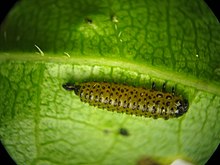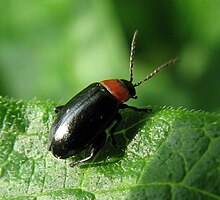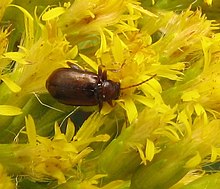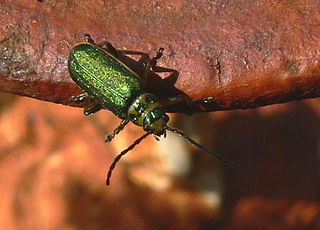
The Galerucinae are a large subfamily of the leaf beetles (Chrysomelidae), containing about 15,000 species in more than 1000 genera, of which about 500 genera and about 8000 species make up the flea beetle tribe Alticini.
Catherine N. Duckett is the Associate Dean of the School of Science at Monmouth University. Formerly she worked as Associate Director of the Office for the Promotion of Women in Science, Engineering and Mathematics, and the Program Manager of the Ocean Biogeographic Information System at Rutgers University, as well as a former Associate professor of Biology at University of Puerto Rico at Rio Piedras. She is also a prominent systematic entomologist, specializing in the phylogeny of flea beetles, and an adjunct professor at Rutgers.

Altica is a large genus of flea beetles in the subfamily Galerucinae, with about 300 species, distributed nearly worldwide. The genus is best represented in the Neotropical realm, well represented in the Nearctic and Palearctic, but occurs also in the Afrotropic, Indomalaya, and Australasia. The species are similar to each other, small metallic blue-green-bronze beetles, often distinguished from each other only by the aedeagus. The species of Altica, both as larvae and as adults, are phytophagous, feeding on plant foliage of various food plant taxa, specific for each Altica species. Onagraceae and Rosaceae are the dominant host plant families for Holarctic species. The adult Altica beetles are able to jump away when approached.

Phyllotreta undulata, known generally as the small striped flea beetle or turnip flea beetle, is a species of flea beetle in the family Chrysomelidae. It is found in Australia, Europe and Northern Asia, North America, and Oceania.

Eumolpini is a tribe of leaf beetles in the subfamily Eumolpinae. It is the largest tribe in the subfamily, with approximately 170 genera found worldwide. Members of the tribe almost always have a longitudinal median groove on the pygidium, which possibly helps to keep the elytra locked at rest. They also generally have a subglabrous body, as well as appendiculate pretarsal claws.
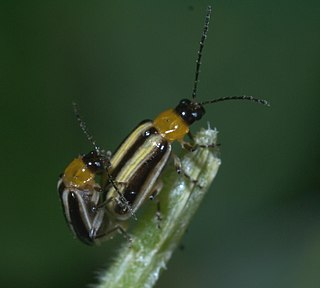
Luperini is a tribe of skeletonizing leaf beetles in the family Chrysomelidae. There are more than 30 genera and 500 described species in Luperini.
Acallepitrix is a genus of flea beetles in the family Chrysomelidae. There are more than 20 described species in Acallepitrix. They are found in the Neotropics, Central America, and North America.
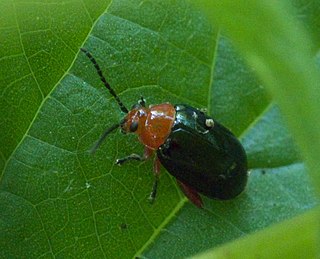
Asphaera is a genus of flea beetles in the family Chrysomelidae, containing some 130 species, found in North America, Central America, and the Neotropics.
Phyllotreta liebecki is a species of flea beetle in the family Chrysomelidae. It is found in North America.

Chrysochus is a genus of leaf beetles in the subfamily Eumolpinae. It is known from North America, Europe and Asia.

Blepharida is a genus of leaf beetles of the subfamily Galerucinae. They have co-evolved with plants in the genus Bursera, which they feed on. The plants have developed a sticky, poisonous resin that sprays out when the leaves are bitten into, and the beetles have evolved to cut through the veins of the leaves to disable this mechanism first. There are currently 73 known species in Blepharida, which are found in the Nearctic, Neotropical, Afrotropical and southern Palearctic realms.

Coelomera is a genus of beetles belonging to the family Chrysomelidae.

Podontia is a genus of flea beetles in the family Chrysomelidae. They belong in the Blepharida-group of flea beetles.

Macrohaltica is a genus of flea beetles in the family Chrysomelidae. There are about 20 described species in Macrohaltica, found in Central and South America.

Cacoscelis is a genus of flea beetles in the family Chrysomelidae, found in southern North America, Central America, and South America.

Walterianella is a genus of flea beetles in the family Chrysomelidae. There are more than 40 described species in Walterianella. They are found in Central and South America.
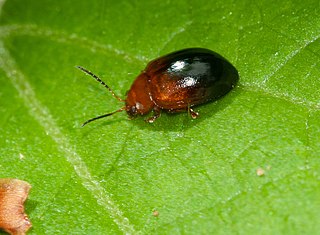
Nisotra is a genus of flea beetles in the family Chrysomelidae. They are found in Africa, Asia, and Australia. There are around 90 described species in Nisotra, including about 70 in Sub-Saharan Africa and Madagascar. Many of these species are agricultural pests.
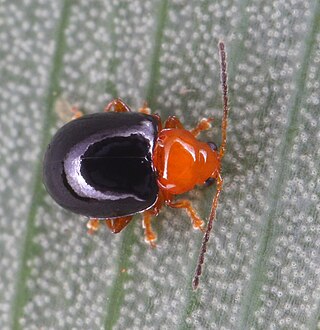
Stuckenbergiana is a genus of flea beetles belonging to the family Chrysomelidae. There is a single described species, Stuckenbergiana glabrata, which is found in South Africa.

